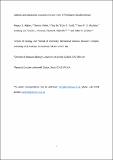Catalytic and anticatalytic snapshots of a short-form ATP phosphoribosyltransferase
Abstract
Allosteric modulation of catalysis is a common regulatory strategy of flux-controlling biosynthetic enzymes. The enzyme ATP phosphoribosyltransferase (ATPPRT) catalyzes the first reaction in histidine biosynthesis, the magnesium-dependent condensation of ATP and 5-phospho-α-d-ribosyl-1-pyrophosphate (PRPP) to generate N1-(5-phospho-β-d-ribosyl)-ATP (PRATP) and pyrophosphate (PPi). ATPPRT is allosterically inhibited by the final product of the pathway, histidine. Hetero-octameric ATPPRT consists of four catalytic subunits (HisGS) and four regulatory subunits (HisZ) engaged in intricate catalytic regulation. HisZ enhances HisGS catalysis in the absence of histidine while mediating allosteric inhibition in its presence. Here we report HisGS structures for the apoenzyme and complexes with substrates (PRPP, PRPP-ATP, PRPP-ADP), product (PRATP), and inhibitor (AMP), along with ATPPRT holoenzyme structures in complexes with substrates (PRPP, PRPP-ATP, PRPP-ADP) and product (PRATP). These 10 crystal structures provide an atomic view of the catalytic cycle and allosteric activation of Psychrobacter arcticus ATPPRT. In both ternary complexes with PRPP-ATP, the adenine ring is found in an anticatalytic orientation, rotated 180° from the catalytic rotamer. Arg32 interacts with phosphate groups of ATP and PRPP, bringing the substrates in proximity for catalysis. The negative charge repulsion is further attenuated by a magnesium ion sandwiched between the α- and β-phosphate groups of both substrates. HisZ binding to form the hetero-octamer brings HisGS subunits closer together in a tighter dimer in the Michaelis complex, which poises Arg56 from the adjacent HisGS molecule for cross-subunit stabilization of the PPi leaving group at the transition state. The more electrostatically preorganized active site of the holoenzyme likely minimizes the reorganization energy required to accommodate the transition state. This provides a structural basis for allosteric activation in which chemistry is accelerated by facilitating leaving group departure.
Citation
Alphey , M S , Fisher , G , Ge , Y , Gould , E R , Guerreiro Machado , T F , Liu , H , Florence , G J , Naismith , J H & da Silva , R G 2018 , ' Catalytic and anticatalytic snapshots of a short-form ATP phosphoribosyltransferase ' , ACS Catalysis , vol. 8 , no. 6 , pp. 5601-5610 . https://doi.org/10.1021/acscatal.8b00867
Publication
ACS Catalysis
Status
Peer reviewed
ISSN
2155-5435Type
Journal article
Description
This work was supported by the University of St Andrews, a Leverhulme Trust grant (RL - 2012 - 025) to G.J.F, the Engineering and Physical Sciences Research Council (EPSRC) [grant number EP/L016419/1] via a CRITICAT Centre for Doctoral Training studentship to TFGM, and the Biotechnology and Biological Sciences Research Council (BBSRC) [grant number BB/M010996/1] via an EASTBIO Doctoral Training Partnership studentship to GF.Collections
Items in the St Andrews Research Repository are protected by copyright, with all rights reserved, unless otherwise indicated.

